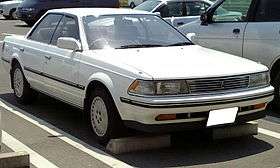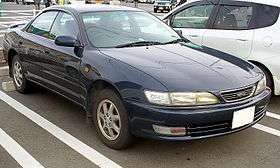Toyota Carina ED
| Toyota Carina ED | |
|---|---|
| Overview | |
| Manufacturer | Toyota |
| Production | 1985-April 1998 |
The Toyota Carina ED was a Japanese compact car created in 1985 as a companion to the 1984 Carina sedan. It was positioned as the 4-door Celica, with a similar focus on luxury found on larger Toyota hardtop sedans, like the Toyota Crown and the Toyota Cresta. When the Carina ED was discontinued, the Toyota Brevis appeared for the market segment served by the Carina ED.
First Generation (1985-1989) ST160 series
| First Generation | |
|---|---|
 | |
| Overview | |
| Production | 1985-1989 |
| Body and chassis | |
| Body style | 4-door hardtop |
| Layout | Front engine, FWD |
| Related |
Toyota Celica Toyota Corona Toyota Corona Coupe Toyota Carina |
| Powertrain | |
| Engine |
2.0L i4 DOHC 3S-GELU 1.8L i4 SOHC 1S-ELU 1.8L i4 SOHC 1S-iLU |
| Transmission | 5MT / 4AT |
| Dimensions | |
| Wheelbase | 2,525 mm (99.4 in) |
| Length | 4,500 mm (180 in) |
| Width | 1,690 mm (67 in) |
| Height | 1,320 mm (52 in) |
The first generation was a new design direction, emphasizing styling and comfort over practicality and economy. The Celica platform was used and attention was placed on handling and performance. Fog lamps were made standard August 1987. The 1S-ELU was replaced by the 2.0 L 3S-FELU, and May 1988, the 1S-iLU was replaced by the 1.8 L 4S-FiLU.
When the first Carina was introduced in 1970, it was identified as a four-door Celica, but sold at a different Toyota Japan dealership called Toyota Store as a Corona-sized sedan with the performance-enhanced image of the Celica. The Corona was exclusive to Toyopet Store, and the Celica was exclusive to Toyota Corolla Store. The introduction of the Carina ED represented a reintroduction of the performance reputation of the Celica, once again as a four-door version.
Its design sought to emulate the hardtop four-door coupé styling of large American and European sedans, resulting in a small, low cabin with longer front and rear ends. The ED's B-pillar stood up in the middle with no purpose other than to hinge the rear door on; it was not attached to the roof side of the cabin. The ED achieved huge sales in Japan, and other Japanese manufacturers introduced the Mazda Persona, Nissan Presea, and Mitsubishi Emeraude around the same time. "ED" is the initials of "Exciting" and "Dressy".
The hardtop approach was also used on the yet smaller Corolla/Sprinter platform, called the Corolla Ceres and the Sprinter Marino; these cars were offered for consumers who wanted the luxurious approach offered by the Toyota Crown hardtop and sedan, as well as the Mark II (4-door sedan), Cresta (4-door hardtop) and Chaser (4-door hardtop and performance enhancements) but at a lower price and reduced tax liability based on the vehicles size and engine displacement.
Second Generation (1989 - 1993) ST180 series
| Second Generation | |
|---|---|
 | |
| Overview | |
| Production | 1989-1993 |
| Body and chassis | |
| Body style | 4-door hardtop |
| Layout | Front engine, FWD |
| Related |
Toyota Corona EXiV Toyota Celica Toyota Corona Toyota Carina |
| Powertrain | |
| Engine |
2.0L i4 DOHC 3S-FELU 1.8L i4 SOHC 4S-FiLU |
| Transmission | 5MT / 4AT |
| Dimensions | |
| Wheelbase | 2,525 mm (99.4 in) |
| Length | 4,485 mm (176.6 in) |
| Width | 1,690 mm (67 in) |
| Height | 1,315 mm (51.8 in) |
The restyled second generation was introduced 1989 and luxury equipment content increased. Four wheel steering appeared on the top level offering and styling was updated more closely resemble the twin introduction of the Toyota Corona EXiV, and shared it appearance with the Toyota Corona and Toyota Carina. Electronic fuel injection was made standard on all engines offered. The car was the last true hardtop as the next generation had a complete B pillar extending all the way to the roof.
Third Generation (1993 - 1998) ST200 series
| Third Generation | |
|---|---|
 | |
| Overview | |
| Production | 1993-1998 |
| Body and chassis | |
| Body style | 4-door hardtop |
| Layout | Front engine, FWD/AWD |
| Related |
Toyota Corona EXiV Toyota Curren Toyota Celica Toyota Corona Toyota Carina |
| Powertrain | |
| Engine |
2.0L i4 DOHC 3S-GE 2.0L i4 DOHC 3S-FE 1.8L i4 SOHC 4S-FiLU |
| Transmission | 5MT / 4AT |
| Dimensions | |
| Wheelbase | 2,525 mm (99.4 in) |
| Length | 4,500 mm (180 in) |
| Width | 1,740 mm (69 in) |
| Height | 1,325 mm (52.2 in) |
The four wheel drive system introduced on this generation was borrowed from the Toyota Celica GT-Four. The 3S-GE engine as a result did not have four wheel steering. The trim level designations were 1800V, 2000X, 2000GT and 2000GT-4WD. As a result of styling changes, sales improved in comparison to the second generation. A driver side airbag appeared September 1995, as well as speed sensitive door locks and climate control air conditioning. A passenger side airbag appeared June 1996. Production ended due to economic conditions April 1998.
| Wikimedia Commons has media related to Toyota Carina ED. |